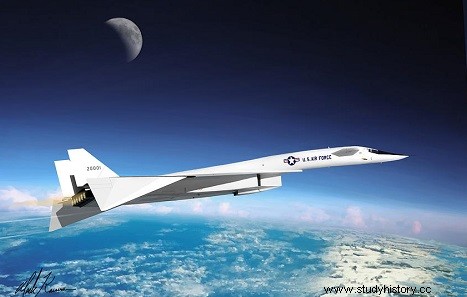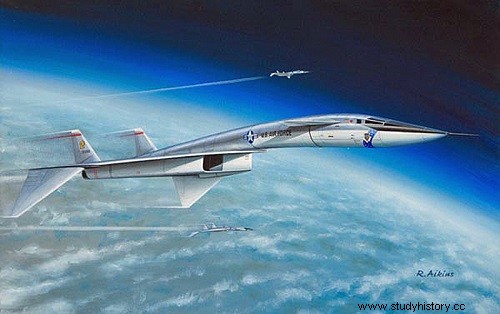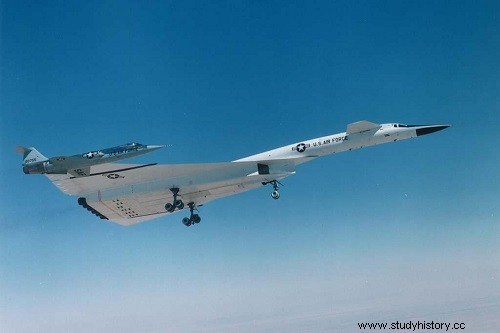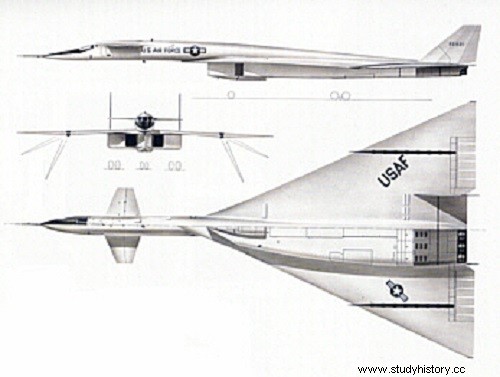
The North American XB-70 Valkyrie is the prototype of the B-70 strategic nuclear penetrating bomber for the United States Air Force's Strategic Air Command. North American Aviation designs the Valkyrie as a large, six-engine aircraft capable of reaching speeds in excess of Mach 3 when flying at 21,000 m (70,000 ft).
Thanks to this maximum speed and altitude performance, the B-70 was supposed to be almost invulnerable to interceptor aircraft, the only real defense against bombers at the time. Its high speed made the aircraft difficult to distinguish on radar screens and its high flight altitude was beyond the capabilities of Soviet fighter aircraft of the time. Even if detected, the aircraft will only spend a very short time in the detection volume of a given radar station anyway, leaving no time for GCI controllers to successfully conduct an interception using the alert hunters.
The arrival of the first Soviet surface-to-air missiles at the end of the 1950s called into question the quasi-invulnerability of the B-70. In response, the USAF launches missions at low altitudes, where the radar horizon of missile control centers is limited by local terrain. In its role, known as penetration, the B-70 performs slightly better than the B-52 it is to replace. It is, however, much more expensive and has a smaller range. A certain number of alternative missions are proposed but they only meet with limited interest. As the strategic mission shifted from bombers to intercontinental ballistic missiles (ICBMs) in the late 1950s, manned bombers were increasingly seen as anachronistic.
The USAF finally stopped fighting for its production and the B-70 program was canceled in 1961. Development then became a research program to study the effects of long-duration high-speed flight. As such, two prototypes were built and designated XB-70A; these aircraft were used for supersonic test flights between 1964 and 1969. In 1966, a prototype crashed after a mid-air collision with an F-104 fighter; the remaining Valkyrie bomber is in the National Museum of the United States Air Force, Ohio.
Development
As a continuation of Boeing's MX-2145 piloted rocket bomber project, the manufacturer joined forces with the RAND Corporation in January 1954 to study what kind of aircraft would be needed to drop the various nuclear weapons then in development. Although long range and high payload are obvious requirements, they also conclude that after the nuclear bombs are dropped, the bomber must be supersonic in order to escape the blast of the explosion. The aircraft must also be large enough to carry a decent bomb load and sufficient fuel for out-of-supply missions between the contiguous United States and the Soviet Union.
For some time, the aviation industry is studying the matter. Since the mid-1940s, there has been much interest in using nuclear-powered aircraft in the bomber role. In a conventional jet engine, power is provided by accelerating air, which is achieved by heating it through fuel combustion. In a nuclear engine, heat is provided by a reactor, although a small amount of fuel is carried for use during take-offs and high-speed passes. An alternative is to use highly energetic fuels (zip fuels), enriched with boron, which improves the energy density of the fuel by about 40%, and can be used on versions of already existing reactors. High-energetic fuels seem to offer enough performance improvements to produce a strategic bomber that can reach supersonic speeds.
WS-110A
The USAF followed these developments closely, and in 1955 issued General Operational Requirement No. 38 for a new bomber with the load and intercontinental range of the B-52 and the Mach 2 top speed of the Convair B- 58 Hunter6. The new bomber was to enter service in 19637. A nuclear version and another conventional were then studied. The nuclear-powered bomber is placed under the "Weapon System 125A" and accompanied by the jet-powered version, "Weapon System 110A".
For the WS-110A, the USAF Air Research and Development Command (ARDC) requests a chemical fuel bomber with a cruise speed of Mach 0.9 and the highest speed possible over a distance of 1,852 km (1,000 NM), for flight in the vicinity of the target. The payload should be 22,670 kg (50,000 lb) and the range 7,400 km (400 NM)1. The Air Force had similar requirements in 1955, for the WS-110L, an intercontinental reconnaissance system; but it was canceled in 1958 due to a better choice9,10,11. In July 1955, six subcontractors were selected to submit proposals for the studies of WS-110A8. Boeing and North American Aviation (NAA) submit proposals and, on November 8, 1955, receive contracts for Phase 1 development.
The turning point

The B-70 bomber is an obsolete weapon even before its first flight:the Red Army's ability to destroy stratospheric aircraft using surface-to-air missiles (the cause of the destruction of Gary Powers' U-2 in 1960) caused a change of orientation in the choice of strategic vectors. This favored on the one hand the development of ICBMs, on the other hand that of planes penetrating enemy airspace at low altitude, under the beam of radars and sheltered from anti-aircraft missiles. In 1962, by decision of Robert McNamara then Secretary of Defense of the United States, the project of a tri-sonic bomber flying at high altitude was abandoned. For a moment, a strategic reconnaissance/attack version is considered before being, in turn, abandoned. It should have been called RS-70 (RS for Reconnaissance Strike). Two copies of the XB-70 are however built as part of a collaboration between the USAF and NASA for research purposes. From 1964 to 1969, they carried out more than 120 test flights, reaching a speed of Mach 3.08 and an altitude of 23,000 meters and clearing the issues related to the development of a possible supersonic commercial aircraft.
Built prototypes
Air Vehicle 1 (AV1)
The first copy of the XB-70 left the workshops of Air Force Plant 42 on May 11, 1964 in Palmdale. It is covered with a white livery so as not to absorb the thermal radiation of the sun. The front of the aircraft, in front of the cockpit, is painted black, so that the sun's rays are absorbed by the color and do not dazzle the pilot and co-pilot during high-altitude flights. It took off on September 21, 1964, piloted by Colonel Joe Cotton. From the first subsonic flights the paint comes off in patches. This problem, quite anecdotal, is quickly resolved. The plane reached Mach 1 on October 12, 1964 during the third flight then Mach 2 on March 24, 1965 during the eighth flight. As the speed of testing increases, another, more serious problem arises:honeycomb panels are coming loose. One of these incidents led to the complete loss of three engines by ingestion of debris (the plane crashed into the three other engines, also damaged). Finally the AV1 reached mach 3 on October 14, 1965 during its seventeenth flight. It has since become the heaviest aircraft to have ever flown at this speed. Short-lived triumph:after two minutes a bulky wing element breaks off. This time again the plane manages to return. The USAF therefore prefers to limit it to Mach 2.5, especially since it now has AV2.
The second copy of the XB-70 is equipped with a front radome, without radar, as well as additional avionics elements. Having benefited from the experience of the first prototype, certain steel elements have been replaced by titanium. It is therefore lighter than the AV-1 and no longer presents any loss of structural elements in flight. It reaches Mach 3.07 and proves capable of maintaining this speed for half an hour.
The AV2 accident

Moments after the collision:the F-104 disintegrates into a ball of fire as the Valkyrie seems to continue its flight despite the destruction of its empennage.
On June 8, 1966, the second prototype of the XB-70 left Edwards Air Force Base to perform sonic boom measurements for NASA and the FAA. On the way back, a formation flight was to allow General Electric, manufacturer of the XB-70 engines, to take publicity photos of the aircraft alongside an F-4B Phantom II, an F-104N Starfighter, an F- 5A Freedom Fighter and a T-38 Talon, all powered by company engines.
During this return flight, the F-104N Starfighter, caught in the wake turbulence generated by the XB-70, struck it and destroyed its left vertical stabilizer. The pilot of the F-104, Joseph Albert Walker, is instantly killed. After sixteen seconds of flight, the bomber went into a spin and then crashed. Al White, the pilot, ejects in time but his co-pilot Carl Cross fails to operate his capsule due to centrifugal force and perishes. The loss of the second copy, the only one really capable of reaching mach 3, is a blow for this expensive program. This formation flight not having been formally authorized by the military hierarchy, several officials were hastily and severely punished. Despite everything, the program continues and thirty flights are still carried out with the remaining aircraft.
At the end of the program, the intact prototype is exhibited at the US Air Force Museum where it took its last flight, in 1969.
Consequences
The development of a supersonic commercial aircraft by the United States was abandoned at the same time, the tests of the XB-70 having revealed several problems that were difficult to overcome, in particular that of the nuisances linked to the sonic booms generated by a large aircraft during of transcontinental flights.
The B-52 that the B-70 should have replaced proved to be perfectly suited to its new low-altitude penetration mission and remained the spearhead of the Strategic Air Command until on the arrival of the B-1B and then the B-2.
The B-70 bomber program strongly influenced the Soviet Union, which decided to also design a supersonic bomber but with a medium range of action:the Sukhoï T-4 (also abandoned without being able to reach mach 3); as well as a fighter capable of intercepting a tri-sonic bomber like the Valkyrie:the MIG-25 “Foxbat”, which remains the fastest aircraft in service.
Features (XB-70A)
General characteristics
Builder North American
Role Strategic Bomber Supersonic Research Aircraft
Status Retired
First flight September 21, 1964
Date of withdrawal February 4, 1969
Investment $1.5 billion
Unit cost $750 million (average cost)
Number built 2

Motorization
Engine General Electric YJ93-GE-3
Number 6
Type Turbojet engine with afterburner
Unit thrust 84 kN dry 128 kN with PC
Dimensions
Wingspan 32.0 m
Length 57.6 m
Height 9.1 m
Wing area 585 m2
Masses
Empty 115,030 kg
With armament 242,500 kg
Maximum 246,000 kg
Performance
Cruising speed 3,200 km/h
Maximum speed 3,309 km/h (Mach 3.1)
Ceiling 23,600 m
Range of action 6,900 km
Crews :2
Wing profile :hexagonal; 0.30 Modified Root Hex, 0.70 Modified End Hex
Internal Fuel Capacity :136,100 kg or 177,000 L
